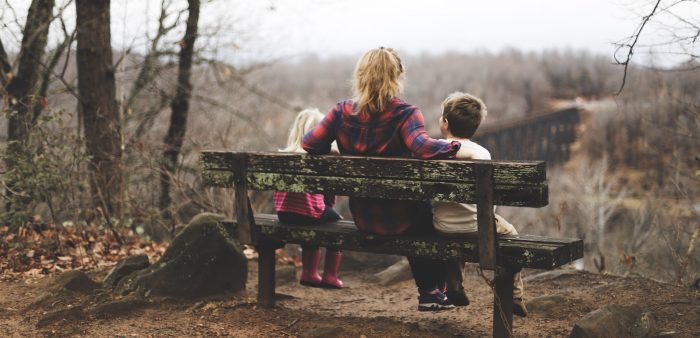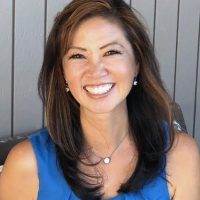“Be who you needed when you were younger.”
This was a profound lesson I learned as a volunteer in my daughter’s kindergarten classroom. I was a 39-year-old mother and wife who was beginning to understand various family dynamics that I couldn’t piece together as a child.
~
“How’s it going?” I asked, peering over the mop of tousled, dark hair.
Jed pouted as he struggled to eke out a sentence under his illustration of two people—one male and one female—who stood side by side, smiling, drawn in a style typical of kindergarten art.
It was volunteer day in my daughter, Jennifer’s, classroom. Every Tuesday morning for an hour and a half, I rolled up my sleeves and cut out materials for an upcoming art project, stapled weekly homework packets of addition facts, or worked with the children on their printing practice.
Today was a writing “assessment” day. The prompt was, “What fun things do you like to do with your family?” Naturally, as her mother, I started by Jennifer’s desk and watched her write, “I like waching moovs with my family.” I continued around the classroom to help kids sound out words like “/P/-/ar/-/k/” or directly offer more difficult-to-spell words like “bicycles.”
Nearly everyone contentedly worked on their prompts. Some meticulously printed and illustrated, coloring in between the lines. Others scribbled out words onto their lined paper alongside an abstract artwork.
But the face that caught my attention was Jed’s: so angry, so conflicted. I stooped down next to him on the side of his desk. “What do you think you’ll write for your sentence, Jed?” I prodded gently.
With his face cupped in his hands, his eyebrows furrowed, he replied with an adamant, “I don’t know.”
“Well, what do you like to do for fun with your family? Watch movies? Ride bikes?” I offered, drawing from ideas I had observed among his classmates.
Silence. Pouting.
“I like the picture you drew,” I encouraged. “They look like they’re happy here. Who are they and what are they doing?”
Jed let out a heavy, shuddered sigh. “My mom and dad don’t like each other.”
Silence—my turn this time. My heart momentarily sank.
Clearing my throat, I responded, “Well…the people in your picture are smiling. They look like they’re having fun. Who did you draw?”
Jed looked down at his illustration as though he’d forgotten it was there. “That’s me and my sister at the park. Because my mom and dad don’t get along.”
“How about we write a sentence about playing at the park with your sister? She’s part of your family and it looks like you guys have fun playing there together. The sentence can be about just the two of you.”
Jed’s eyebrows started to soften, and he suddenly sat up a little taller, a little straighter in his chair. “Yeah. Okay,” he said. His clumsy little fingers curled around the thick, yellow pencil as he looked at me and asked, “How do I spell ‘sister?’”
~
In that small moment of crisis and emotional heartbreak, I could not process the gravity of not only Jed’s words, but his world, as well as his position in it. It wasn’t until after I had hugged and kissed Jennifer at her morning snack recess—the break that signaled the end of my volunteer time—and then signed myself out at the front office and began walking to my car that I felt the weight of Jed’s statement. And it slowed the gait of my walk.
My mom and dad don’t like each other.
My heart hurt. Both it and my throat constricted—and I remembered.
I remembered feeling the powerlessness a child experiences watching and hearing the two most important people in your life shouting and yelling at each other. How, with each escalation in their tone, or bitterness in their words, it slapped you. You cringed. Your entire being shrunk into itself. “Please stop!” you’d scream from the inside. “Stop fighting!”
Even when the word-slinging stopped, the residual coldness remained in the house, and the words left unsaid lingered and haunted. As a child, it was hard to tell which was worse. Both seemed to break your carefree spirit. Both left you feeling miserably alone and scared.
I had seen Jed’s parents—once at a “Back to School” night and once more during pick-up time after school. His mother struck me as preoccupied and exasperated. Jed’s father, while quiet and resigned, appeared to be the more interactive parent with his children. I had observed them from afar without judgment.
Had I been living the perfect model of a blissful family life and marriage, I easily could have judged the pair of them. Or focused on her: What kind of mom are you, creating a setting in your children’s lives that your five-year-old son can’t write a single, positive sentence about your family?! Get it together, woman!
I sighed. Those critics certainly exist. I wasn’t hypocritical enough to be one.
As heavy as it was to remember the misery of being the child of a less-than-happy marriage, I now also bore the burden of being one-half of said marriage. I couldn’t judge Jed’s mom because I was her. At least, the distracted and aggravated part of her I superficially observed.
I was aware that I was also a parent who was setting up a dysfunctional environment for my family, because I was fighting with my husband—a lot. Whatever baggage and insecurities we were subconsciously harboring from our past, even as far back as our childhood, were being acted out in our marital dynamics.
As a child, I had taken my parents’ altercations and outbursts personally and absorbed the toxic energy as if it were my fault. Now, as an adult in the “hot seat” myself, I knew it had nothing to do with my own faultless, precious children. Mommy and Daddy have their own sh*t to process. Sadly, the kids can’t always be shielded or immune from watching and hearing it.
Life sucks like that. You can’t know then what you know now to help you process your childhood trauma and sadness.
It wouldn’t have been my place—but if I could rewind the day and put myself back in the classroom, I would tell Jed, “Your daddy and mommy not liking each other has nothing to do with you, even though it might feel like it has everything to do with you. Right now, you are the grown-up watching them throw temper tantrums. And all you can do is let them. Be the bigger boy who can go have fun with your sister at the park, with smiles on your faces and resilience in your hearts.” And I would hope to convey to him his wisdom, however green and raw, far exceeded theirs. As it did mine.
Jed’s honest connection that day drew out my inner child’s memories. She, in turn, tugged on the shirt of the mother and wife I had become to remind me:
Be present and aware. Heal what hurts so it doesn’t cycle downward. Remember what you needed to know and feel as a child to have a sense of safety in your world.
Heed the message, “Be who you needed when you were younger.”











Read 24 comments and reply